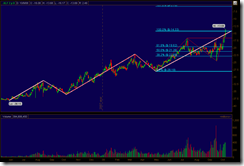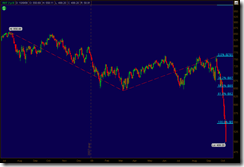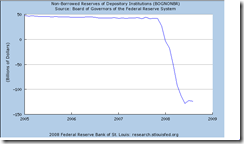Many people, including myself, thought today could be a short-term bottom. At least the market could take a rest at this point. Unfortunately we got the 7th red candle.
I have been kept calling 92x in the past based on the wave counting. It was my mid-term target and I expected seeing it in 2009 or at least several months later.
This is a big surprise to me that the third wave could be such violent. The Fib 100% (bottom of the last bear market after the dot com bubble) is not far away, and the market could reach there in a matter of hours. Now the important question is when we can safely long or short, not catching the falling knife. At this moment, the market can go either directions, and short is as risky as long.
Take a look at a few charts first.
XLF daily:
QQQQ daily:
Russell 2000 index:
Markets around the world are all diving dramatically:
Needless to say, the market is extremely oversold and major distribution day shows up one by one. Will here be the bottom over the intermediate term? Is this time different? Let's see more charts and understand how bad the economy is.
BOGNONBR: Non-borrowed reserves of depository institutions
Here is an excellent explanation to the chart (thanks to Bob Hernon):
The central bank requires member banks to keep a small % of deposits on hand, that is not loaned out to anyone.
Anything above the required minimum is called "excess reserves".
If a bank reserves drop below the minimum, they are required to borrow reserves from other banks that have excess to meet their minimums. The interest rate on those inter-bank borrowings is the Fed Funds rate.
Negative numbers here then are the sum of reserves that had to be borrowed to meet minimum requirements.
I suspect this chart demonstrates the net effect of the recent bank runs we've seen across the country. I don't think the credit market will be out of the woods until we have positive non-borrowed reserves.
The statistics started from 1959. Now it is the worst and the first time the excess reserves go below zero:
The banking system is nearly frozen. However the banks are still borrowing money, here is the explanation:
Right now the banking system as a whole has nothing it can lend to consumers since as a whole the minimum reserves in the system are borrowed. My guess is the borrowing comes from the TAF, which is around $150 billion of Fed assets loaned to banks.
 (chart source and description)
(chart source and description)
The money multiplier has taken a dive recently. This indicator tracks the velocity of money used in commerce that is not used to extinguish debt. Historically a value of 2.0 is growth, 1.8 is considered as stagnation, and 1.6 is considered as recession (thanks to Bad McClure).
What is FED doing? Apparently they are "producing" money which is shown on the following chart of the Monetary Base:
Also skim through today's Fed H3 statistical release, besides the stunning number of non-borrowed reserves and increasing monetary base, one can see that total reserves reach a new high, which means the banks would rather hoard their money (including the money borrowed from the Fed) than lending out. As I talked before, Fed actually pays interests to those reserved money from the banking system from 2008 (previously planned 2011), then the facts are:
- Fed is borrowing money to banking system in order to prevent more failures and injecting fund to the market;
- Banking system is reluctant to lend money out because of extremely uncertainty, and they are happy to put money in Fed Reserve and get paid by doing this;
- At the moment Fed cannot really control the target rate (refer to the published Fed funds data). As the market is free falling, Fed is losing control.
Lastly let's look at the ever increasing TED spread:
If it does not go back to the level in the middle 2007, the market won't calm down and the economy won't grow.
We are experiencing a life-time event, and this time is extraordinary. The financial crisis, the meltdown of the banking system, makes this time dramatically different than dot com bubble burst or the 1987 black Monday. Therefore we should be very careful and never have a wishful thinking that we are approaching a long-term bottom. There will be several tradable rallies, but the primary trend is down, and the bear market will disappoint most individual or institutional investors.
With respect to tomorrow, take notice that:
- Morgan Stanley Credit Rating May Be Cut by Moody's (Update1). Yes, they want one more bank run.
- Bush will give a talk before the bell rings;
- GE's report pre-market;
- Lehman's CDS selling in Europe.
Any one of them could be a potential bomb to the market. If you still wait to catch the falling knife, think twice.












No comments:
Post a Comment